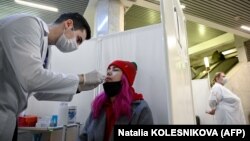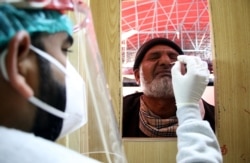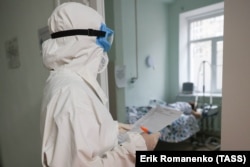When St Petersburg's Polytechnic University announced on December 20, 2021, that dozens of students in college accommodation had contracted COVID-19 and were self-isolating in a facility outside the city, the news immediately prompted fears that the omicron variant surging in the West since early December, and leading to rates of illness and hospitalization not seen for months, had finally taken hold in Russia.
As relatives sought information, and the university failed to supply exact numbers of those who tested positive, it fell on independent sleuths to conclude that the majority of the cases could be attributed to the highly infectious new coronavirus variant.
RFE/RL's Coronavirus Coverage
Features and analysis, videos, and infographics explore how the COVID-19 pandemic is affecting the countries in our region.
"Active spread [of omicron] has begun," Aleksandr Solovyov, a prominent Russian doctor and member of the Federation of Laboratory Medicine, wrote on Facebook on December 21.
But a day after the incident, Anna Popova, the head of Russia's coronavirus task force, said that only 41 omicron cases had been discovered in the country, without clarifying if they had resulted from local spread or had been detected in arrivals from abroad.
'West-To-East Tidal Wave'
Such confusion and contradictory information may harm Russia's preparedness as the country steels itself for what the World Health Organization (WHO) warns is a "west-to-east tidal wave" of omicron infections that will soon see half of Europe infected and may hit vaccine-skeptic populations like Russia's the hardest.
"I am deeply concerned that, as the variant moves east, we have yet to see its full impact in countries where levels of vaccination uptake are lower, and where we will see more severe disease in the unvaccinated," Dr. Hans Kluge, the WHO's regional director for Europe, said at a news conference on January 11.
In a meeting that same day, members of the Russian government's coronavirus task force warned that the country may soon see six-figure daily infection rates if social distancing and other precautionary measures aren't followed.
"Russia finds itself at a turning point," Health Minister Mikhail Murashko said in comments carried by TASS.
With stubbornly low vaccination rates despite rolling out the world's first approved coronavirus shot in August 2020, Russia is facing the likelihood of a surge in coming weeks as omicron cases rise. Despite evidence from multiple countries suggesting the fast-spreading omicron causes less severe illnesses than previous variants, the WHO has warned that the unvaccinated remain at high risk.
Widespread Distrust
According to Our World In Data, 47 percent of Russia's population has been fully vaccinated. That figure compares to 62 percent of the population in the United States and an average of 70 percent of the population across the countries of the European Union.
And, according to the Russian government, only 5 percent of the population has received a booster shot. Sociologists and health experts say that widespread distrust toward the authorities has severely hobbled the vaccination drive and helped accelerate the rate of infections in Russia.
The politicized rollout of the Sputnik V vaccine after its approval in August 2020, critics say, was not followed by an outreach campaign aimed at persuading weary Russians. No celebrities or senior officials have been vaccinated on camera, and the Kremlin announced only in March 2021 that Putin had received the first dose of a vaccine, without providing any video footage or saying which shot he had been given.
Official statements have continued to add to the confusion. On January 11, coronavirus task force head Popova said that the country had confirmed 305 cases of omicron infection. But, according to an analysis by the Kommersant newspaper published two days before Popova's statement, sequencing data submitted by Russian health experts to international databases suggests that at least 32 percent of the more than 15,000 coronavirus cases recorded in the country each day are omicron.
Murashko, the health minister, said on January 6 that the highly infectious variant is now spreading locally, despite the previous assurances that all new omicron cases had come from abroad.
"Omicron has launched a new wave of the pandemic," the Rossia-24 state news channel declared on January 11 in a report that encouraged Russians to get vaccinated or receive booster shots to blunt the force of the new variant's spread, setting the tone for the TV reports that followed.
Some have dismissed calls for concern. The first week of 2022 saw Russia record the lowest average daily case load since June 2021, prompting optimism as the country began an extended annual holiday following New Year's Eve celebrations. But distrust in official figures remains high amid evidence that they are regularly doctored, and experts insist Russia's omicron epidemic is yet to really begin.
"If we see that omicron cases [in Western countries] are generally mild, we need to remember that those are countries where most older people are vaccinated," epidemiologist Vasily Vlasov told the Dozhd TV channel. "I certainly wouldn't assume that everything will pass as easily here.




